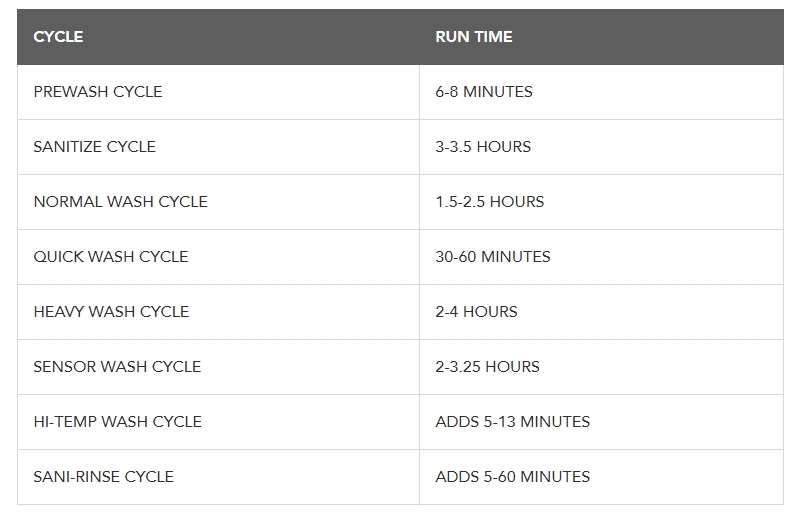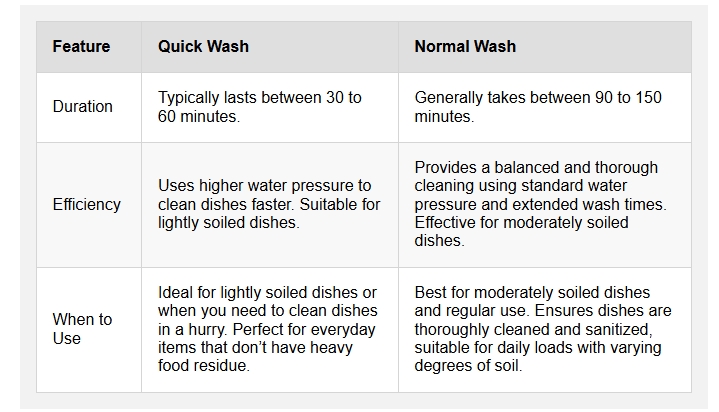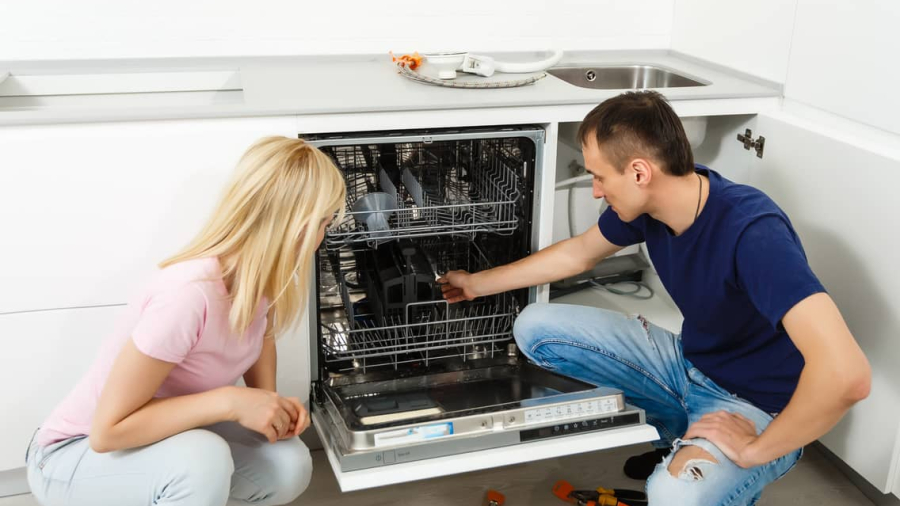Dishwasher cycle lengths can vary massively depending on the age and make of your machine, and the type of cycle function you opt for. Some express cycles may take as little as an hour1, whereas newer, more energy efficient machines may have dishwasher cycles of up-to three hours.But sometimes dishwasher cycle times can last longer than you’d expect. Is this normal, or a sign that something is wrong? Read on to understand why dishwashers can sometimes take a while to complete their cycles and how to know if your appliance is performing at its best.
How long does a dishwasher cycle take?
While it depends on the cycle you choose, most dishwasher cycle times can last anywhere from 1.5 to 4 hours. The average dishwasher running time can vary based on sensor readings, how dirty your dishes are or how long it takes to heat water between cycle phases.
Typical Dishwasher Cycle Times
Dishwasher cycle times generally range from 30 minutes to 4 hours, depending on the settings you choose and the condition of your dishes. Here’s a rundown of the most common cycles and their typical durations, based on insights from appliance experts and manufacturers like Whirlpool, Maytag, and KitchenAid:
- Quick Wash (30–60 minutes): This cycle is your go-to when you need clean dishes fast, like when you’re hosting a party and need to reuse glasses or plates. It’s designed for lightly soiled items, such as cups or dishes you’ve already rinsed. The trade-off? It uses more water and energy to get the job done quickly.
- Normal Wash (1.5–2.5 hours): The default for everyday loads, this cycle handles typical messes like food residue from dinner plates or silverware. It strikes a balance between thorough cleaning and efficiency, making it the most commonly used setting.
- Heavy Wash (2.5–4 hours): Perfect for pots, pans, or dishes with caked-on food (think lasagna pans or greasy baking sheets), this cycle uses extra water and higher temperatures to tackle tough messes. It’s longer because it often includes extended washing and rinsing phases.
- Eco Wash (2–3.5 hours): Found on newer, energy-efficient models, this cycle uses less water and electricity but takes longer to achieve the same level of cleanliness. It’s great for environmentally conscious households but requires patience.
- Auto/Sensor Wash (1.5–3.5 hours): Modern dishwashers often have sensors that detect how dirty your dishes are and adjust the cycle time accordingly. This can lead to variable run times, depending on the soil level.
- Sanitize Cycle (3–3.5 hours): This cycle uses high temperatures (often 140–156°F) to kill bacteria, making it ideal for cutting boards, baby bottles, or dishes used during flu season. The extra heat adds time to the cycle.
- Rinse Only (10–30 minutes): A short cycle that sprays dishes with water to prevent food from drying on before a full wash. It’s useful if you’re not ready to run a full cycle yet.
These times are averages, and your dishwasher’s manual will provide specific durations for your model. For example, a Samsung dishwasher’s normal cycle might run 80–150 minutes, while a Fisher & Paykel DishDrawer on a heavy cycle could take around 175 minutes.

Understanding the Cycles of a Dishwasher
Why Do Dishwasher Cycles Take So Long?
If you’re wondering why your new dishwasher seems to take forever compared to the one you had 10 years ago, you’re not imagining things. Modern dishwashers are designed to be more energy-efficient, which often means longer run times. Here’s why:
- Energy and Water Efficiency Standards: Since 2012, ENERGY STAR® guidelines have pushed manufacturers to reduce water and energy usage. New dishwashers use about 3–4 gallons of water per cycle (compared to 10–15 gallons in older models) and less electricity (under 295 kWh per year). To achieve the same cleaning power with less water, cycles are extended, allowing sensors to fine-tune the process.
- Sensor Technology: Many modern dishwashers use sensors to assess soil levels and adjust the cycle. If your dishes are extra dirty, the dishwasher might add rinse cycles or extend wash time, pushing the cycle closer to 3–4 hours.
- Water Temperature: Dishwashers rely on hot water (ideally 120–140°F) to clean effectively. If your water heater is set too low or far from the dishwasher, the machine may need extra time to heat the water. Some models even pause to heat water between phases, adding 5–13 minutes per cycle.
- Hard Water or Buildup: If you live in an area with hard water, limescale or mineral buildup can clog spray arms or interfere with sensors, causing the dishwasher to default to longer cycles. Regular cleaning with products like affresh® dishwasher cleaner can help.
- Cycle Options: Adding features like heated dry, high-temp wash, or sanitize can extend the cycle by 15–60 minutes. For example, heated dry can add 30–90 minutes, depending on the model.
- First Cycle Calibration: If your dishwasher is brand new, the first cycle may run longer (sometimes over 3 hours) as it calibrates its sensors. This is normal and shouldn’t persist beyond the initial run.
How to Optimize Your Dishwasher’s Run Time
If your dishwasher’s long cycles are driving you up the wall, there are practical steps you can take to make it run more efficiently without sacrificing clean dishes. Here’s how:
- Scrape, Don’t Rinse: Sensors work best when they can detect food particles, so scrape off large bits of food but avoid pre-rinsing. Pre-rinsed dishes might trick the dishwasher into a shorter cycle, but you’re wasting water at the sink.
- Run Hot Water First: Before starting the dishwasher, run the kitchen faucet on hot until the water is warm. This ensures the dishwasher starts with hot water, reducing heating time.
- Use the Right Detergent: Pods or tablets dissolve more consistently than powders or gels, ensuring optimal cleaning and reducing the chance of extended cycles due to residue. Always use dishwasher-specific detergent—never dish soap, which can cause suds and prolong cycles.
- Clean Regularly: Run a cleaning cycle with a product like affresh® or vinegar every 30 days to remove limescale and grease buildup. Clean the filter every 3–6 months to prevent clogs that can slow down cycles.
- Choose the Right Cycle: Match the cycle to the load. Use quick wash for lightly soiled dishes and save heavy or sanitize cycles for tough messes. Avoid adding options like heated dry unless necessary.
- Check for Issues: If cycles consistently run longer than your manual suggests (e.g., a “1-hour” wash taking 155 minutes), check for clogs in the filter or drain hose, or test the water temperature. Persistent issues might indicate a faulty heating element, thermostat, or control board, requiring a technician’s attention.
Factors Affecting Dishwasher Cycle Time
There are a few factors that affect the duration of a dishwasher cycle, like the water temperature, the soil level of your dishes and whether you select an energy-saving cycle.
Understanding what can add or subtract time from your wash cycle can help you choose the right dishwasher setting when you need it.
- Water Temperature: Using a High Temp setting adds anywhere from 5 to 13 minutes to your dishwasher cycle, as it takes additional time to heat the water to the higher temperature.
- Soil Level: If you’re using a Sensor Wash Cycle, the sensors inside the appliance evaluate the soil level of your dishes to run an appropriate wash cycle that coordinates with how dirty your dishes are. If you’re cleaning a large batch of dirty dishes, your machine may run longer than a Normal Wash Cycle.
- Energy Saving Modes: Using Energy Saving settings can cause your dishwasher cycle to run longer. These cycles usually use longer run times and lower water temperatures to help reduce the energy usage of your appliance.
Comparing Quick Wash vs Normal Wash
Understanding the differences between the Quick Wash and Normal Wash cycles can help you choose the right option for your needs. Here’s a comparison table highlighting duration, efficiency, and best usage scenarios:

How Often Should You Run Your Dishwasher?
You don’t need to run your dishwasher every day unless you’re generating enough dirty dishes to fill it. Most manufacturers recommend running it at least once a week to keep the motor seals lubricated and prevent buildup. Waiting for a full load is more energy-efficient, but if you only have a few dishes, a rinse-only cycle or half-load option (if available) can prevent food from caking on.
Running a nearly empty dishwasher, as some detergent brands suggest, wastes water and energy. For example, running a dishwasher with just eight dishes daily could add 900 gallons of water and 225 kWh of electricity per year to your household usage. Stick to full loads whenever possible to maximize efficiency.
Troubleshooting Long Cycles
If your dishwasher is running way longer than expected (say, over 4 hours), here are some common culprits and fixes:
- Clogged Filters or Spray Arms: Food debris or mineral buildup can reduce water flow, causing the dishwasher to extend cycles. Clean the filter and use a bamboo skewer to clear spray arm holes.
- Low Water Temperature: Check your water heater—it should be set to at least 120°F. If it’s lower, the dishwasher will work harder to heat water, adding time.
- Faulty Components: A malfunctioning heating element, thermostat, or sensor can cause cycles to drag. For example, a failed heating element might prevent the water from reaching the right temperature, stalling the cycle. Use a multimeter to test the heating element for continuity, or call a professional.
- Overloading: Packing dishes too tightly can block spray arms, reducing cleaning efficiency and triggering longer cycles. Follow your manual’s loading guidelines.
- Hard Water Issues: If you notice white spots or cloudy glasses, hard water might be affecting sensors. Use a water softener or rinse aid to improve performance.
If you’ve tried these steps and your dishwasher still runs excessively long (e.g., 8 hours, as reported with some Whirlpool models), it’s time to consult a technician. They can check for issues like a faulty control board or motor.
When to Run Your Dishwasher
Timing can also affect your experience. Running your dishwasher at night or during off-peak energy hours (like early morning) can save on utility costs in some areas, as energy rates may be lower. Plus, modern dishwashers are quiet enough that nighttime runs won’t disturb your household. A delay wash option, available on many models, lets you schedule cycles for convenience.
When to Run Your Dishwasher
Timing can also affect your experience. Running your dishwasher at night or during off-peak energy hours (like early morning) can save on utility costs in some areas, as energy rates may be lower. Plus, modern dishwashers are quiet enough that nighttime runs won’t disturb your household. A delay wash option, available on many models, lets you schedule cycles for convenience.
FAQ
Is it cheaper to use a dishwasher or wash by hand?
For most people, using a dishwasher is more energy-efficient than hand washing dishes because it uses less hot water. Is it cheaper to hand wash or use a dishwasher? In most households, the dishwasher uses less hot water than hand washing and is, therefore, a cheaper alternative to washing dishes by hand.
Why you should always run your dishwasher at night?
Not only will the energy cost be less; it’ll keep heat from building up in your kitchen, giving your AC a break.) This means you can lower your energy bill by simply checking your energy company’s specific peak hours and waiting to run your dishwasher during off-peak hours.
How often should you run your dishwasher?
Your dishwashing schedule can vary depending on your household size and how many dishes you go through in a given week. Generally, you should run your dishwasher at least once a week.
Should I run my dishwasher every night?
You can wait to run your dishwasher when you have a full load of dishes, glasses and utensils to clean. You do not need to run your dishwasher every night. Some manufacturers recommend running your dishwasher at least once a week.
Can I open my dishwasher mid-cycle?
You can open your dishwasher mid-cycle – it may disrupt the cycle on certain models (for example, if your dishwasher has a drying cycle), or you may have to press the start button again, but it shouldn’t cause a flood in your kitchen or damage your machine.
For many people, this worry is based on the common misunderstanding that your dishwasher fills up with water as it washes. This is, thankfully, not how your dishwasher works, so while opening the door mid-cycle might result in a little splashing (or a lot of steam being released), you won’t be faced with a tidal wave of water!
Are dishwasher fires common?
Although a dishwasher fire is not the most common appliance-related fires, it can still occur due to poor maintenance, improper usage, electrical problems, or faulty components.
